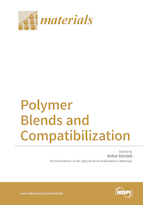Polymer Blends and Compatibilization
A special issue of Materials (ISSN 1996-1944).
Deadline for manuscript submissions: closed (31 May 2016) | Viewed by 82876
Special Issue Editor
Interests: environmentally friendly polymers; lightweight materials; functional polymers; advanced processing & testing
Special Issues, Collections and Topics in MDPI journals
Special Issue Information
Dear Colleagues,
The market is continuously looking for substitutes for expensive polymers or tailor made polymers for specific applications. Therefore, polymer blends are gaining more interest since they possess a great potential to fulfill these needs. Blending results, not only in better final properties, but can also improve the processing behavior and reduce the costs. In the field of polymer blends, there are numerous parameters that influence the morphology, e.g., viscosity ratio, blend composition, shear conditions, and blend ratio. There is still a great deal of potential to scientifically exploit the possibilities of blend technology, which is necessary to obtain a foundation based on science, engineering, technology, and applications in order to make it possible to tailor polymer blends as desired.
However, combining two or more different polymers to receive favorable properties by blending often results in immiscible polymer blends. This immiscibility goes along with phase separation leading to weak mechanical properties. The high interfacial tension causing this can be reduced by compatibilization of polymer blends. There are different methods like adding block and graft copolymers, reactive polymers to form block and graft copolymers, nanoparticles or organic molecules. Using suitable compatibilizers, not only is the interfacial adhesion between matrix and its blends reduced, but also the dispersion of the dispersed phase is improved, the adhesion between the phases is enhanced and the morphology is stabilized. This can lead to improved mechanical and morphological properties.
Designing new polymer blends or improving the properties of immiscible polymer blends by compatibilization is very challenging but a good way to scoop the full potential of polymers for applications and needs.
This Special Issue should be the source of information on all recent aspects of polymer blend technology. It is my pleasure to invite you to submit a manuscript for this Special Issue.
Prof. Dr. Volker Altstädt
Guest Editor
Manuscript Submission Information
Manuscripts should be submitted online at www.mdpi.com by registering and logging in to this website. Once you are registered, click here to go to the submission form. Manuscripts can be submitted until the deadline. All submissions that pass pre-check are peer-reviewed. Accepted papers will be published continuously in the journal (as soon as accepted) and will be listed together on the special issue website. Research articles, review articles as well as short communications are invited. For planned papers, a title and short abstract (about 100 words) can be sent to the Editorial Office for announcement on this website.
Submitted manuscripts should not have been published previously, nor be under consideration for publication elsewhere (except conference proceedings papers). All manuscripts are thoroughly refereed through a single-blind peer-review process. A guide for authors and other relevant information for submission of manuscripts is available on the Instructions for Authors page. Materials is an international peer-reviewed open access semimonthly journal published by MDPI.
Please visit the Instructions for Authors page before submitting a manuscript. The Article Processing Charge (APC) for publication in this open access journal is 2600 CHF (Swiss Francs). Submitted papers should be well formatted and use good English. Authors may use MDPI's English editing service prior to publication or during author revisions.
Keywords
- immiscible polymer blends
- miscible polymer blends
- compatibilization, reactive compatibilization
- block-co-polymers
- interfacial tension
- micro- and nano morphology
- interpenetrating networks
- blend rheology







